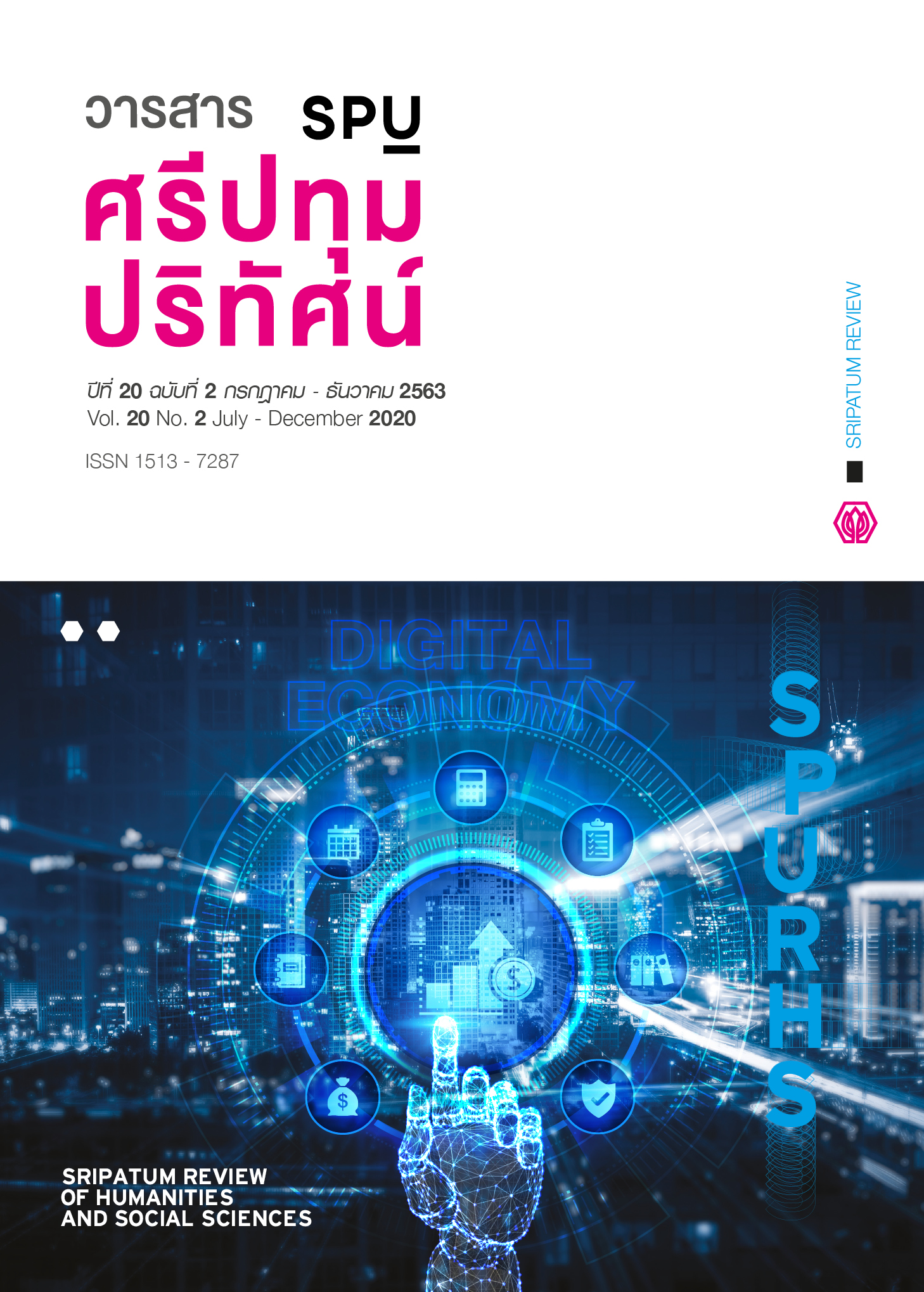Guidelines for Enhancing the Perceived Image of Secondary City Tourism in Thailand: A Case Study of Sing Buri Province
Main Article Content
Abstract
The objectives of this research were (1) to study the perception of tourism image of Sing Buri province that had influences on intention to revisit Sing Buri province; and (2) to propose guidelines for enhancing tourism image awareness of Thai tourists to promote their intention to revisit Sing Buri province. This research was a mixed-method study. In the quantitative study, a questionnaire was used as the research tool for collecting data from 400 Thai tourists who visited Sing Buri province. The data were analyzed using descriptive statistics and inferential statistics of multiple regression analysis. In the qualitative study, data were collected by semi-structured interviews of 12 stakeholders of Sing Buri tourism from the state and private sectors. The collected data were analyzed with thematic analysis. The research findings showed that Thai tourists had opinions that the aspects having the most influence on their intention to revisit was the perceived image of safety and potential of tourist attractions, followed by the accessibility to tourist attractions, the products and services, and the society, culture and traditions, respectively. Based on the findings from both the quantitative and qualitative studies, the researcher acquired the guidelines for enhancing the image of tourism in order to encourage Thai tourists to revisit Sing Buri province as follows: (1) guidelines for increasing the frequency of security checks; (2) guidelines for creating understanding about tourism of people in the local area; (3) guidelines for connecting bus routes of traveling to cover all tourist attractions; (4) guidelines for increasing product diversity and controlling the entry of foreign workers in the service sectors; and (5) guidelines for the development of creative tourism for learning.
Article Details
1. กองบรรณาธิการสงวนสิทธิ์ในการพิจารณาและตัดสินการตีพิมพ์บทความในวารสาร
2. บทความทุกเรื่องจะได้รับการตรวจสอบทางวิชาการโดยผู้ทรงคุณวุฒิ แต่ข้อความและเนื้อหาในบทความที่ตีพิมพ์เป็นความรับผิดชอบของผู้เขียนแต่เพียงผู้เดียว มิใช่ความคิดเห็นและความรับผิดชอบของมหาวิทยาลัยศรีปทุม
3. การคัดลอกอ้างอิงต้องดำเนินการตามการปฏิบัติในหมู่นักวิชาการโดยทั่วไป และสอดคล้องกับกฎหมายที่เกี่ยวข้อง
References
Boonrod, K. (2014). Preparation Guideline for Climate Change in Coastal Tourism Industry. Thesis of the Degree of Master of Tourism Management. Bangkok: Nation Institute of Development Administration. (in Thai)
Chantawanit, S. (2009). Qualitative Research Methods. Bangkok: Chulalongkorn University Press.(in Thai)
Department of Tourism. (2018). Project to propose budget support for tourist attraction development. [Online]. Retrieved September 11, 2018 from: http://61.19.55.30/dot_project/pages/project_detail.php?id=2775.
Ekakun, T. (2009). Research Methodology in Behavioral Science and Social Sciences. 6 ed. Ubon Ratchathani: Faculty of Education of Ubon Ratchathani Rajabhat University. (in Thai).
Jankingthong, W. (2014). Destination Image in Thailand. Journal of Silpakorn University, Thai version, 34(1), 31-50. (in Thai)
Kaewnuch, K. (2019). Influencing Factors on Tour Program Design in Creative Community Based Tourism. WMS Journal of Management, 8(2), 48-58. (in Thai)
Kemapatapan, S. (2015). Media Expose and Thailand’s Tourism Image Perception of Chinese Tourists. An Independent Study of the Degree of Master of Arts Program in Corporate Communication Management. Bangkok: Thamasat University. (in Thai)
Kingthong, P. (2016). The Expectation and the Perception of Adventurous Destination Image: Case Study in Kanchanaburi Province. Thesis of the Degree of Master of Tourism Management. Bangkok: Nation Institute of Development Administration. (in Thai)
Kokkhangplu, A. and Kaewnuch, K. (2017). Guideline to Enhance Performance Efficiency on Tourism Destination in Khanom Community, Nakhon Si Thammarat Province. Dusit Thani College Journal, 11, 138-156. (in Thai)
Limphairot, R. and Pinkkaeo, K. (2015). The effect of cultural tourism image and tourists satisfaction on their revisit intention at Pranakorn Sriauythaya province. Academic conference report and research presentation, the 6th National and International Humanities and Social Sciences, 2 (6), 448-460. (in Thai)
Ministry of Tourism and Sports. (2015). Thailand Tourism Strategy 2015 - 2017. [Online]. Retrieved February 17, 2020 from: https://www.mots.go.th/ewt_dl_link.php?nid=7114.
Ministry of Tourism and Sports. (2017). International Tourist Arrivals to Thailand. [Online]. Retrieved September 19, 2018 from: https://www.mots.go.th/more_news.php?cid= 420andfilename=index.
Ministry of Tourism and Sports. (2018). Situation of domestic tourism in provincial areas in 2018. [Online]. Retrieved April 22, 2019 from: https://www.mots.go.th/more_news.php?cid= 509andfilename=index.
Office of the National Economic and Social Development Board. (2018). Gross Domestic Product Q1/2017. [Online]. Retrieved December 13, 2018 from: http://www.nesdb.go.th/main. php?filename=qgdp_page.
Oliver, R. L. (1999). Whence Consumer Loyalty?. Journal of Marketing, 63, 33-44.
Somjai, S. (2016). The Way to Solve Problems of Migrant Labour In Thailand: A Case Study of Chonburi Province. SSRU Graduate Studies Journal, 2(2), 22-31.
Sonda, J. (2014). Tourism Image and Perception of Marketing Public Relation Affecting Thai Tourisms’ Revisiting Chanthaburi Province. An Independent Study of Master of Business Administration. Bangkok: Bangkok University. (in Thai)
Sukploy, G. (2015). The Comparison between Satun and Trang’s Tourist Destination Image and its Effect on Word-of-mouth of Thai Tourists. Thesis of the Degree of Master of Business Administration. Songkla: Prince of Songkla University.
Thairath. (2018). The charm of the second city 'Chanthaburi' that is second to none. [Online]. Retrieved December 25, 2018 from: https://www.thairath.co.th/content/1375337.
Tourism Authority of Thailand. (2018). TAT launches AMAZING THAILAND GO LOCAL campaign to speed up tourism in 55 cities after the government announced tax deduction. [Online]. Retrieved December 2, 2019 from: https://thai.tourismthailand.org.
Toyama, M., and Yamada, Y. (2012). The relationships among tourist novelty, familiarity, satisfaction and destination loyalty: Beyond the novelty-familiarity continuum. International Journal of Marketing Studies, 4(6), 10-18.
Wang, B., Yang, Z., Han, F., and Shi, H. (2016). Car Tourism in Xinjiang: The Mediation Effect of Perceived Value and Tourist Satisfaction on the Relationship between Destination Image and Loyalty. Sustainability, 9(1), 1-16.
Wisansing, J., Vongvisitsin, T., and Hongchatikul, U. (2016). Community Benefitting through Tourism: DASTA-Thailand Model. World Academy of Science, Engineering and Technology International Journal of Humanities and Social Sciences, 10(4), 1.
World Tourism Organization. (2018a). why-tourism. [Online]. Retrieved August 15, 2018 from: http://www.unwto.org/content/why-tourism.
World Tourism Organization. (2018b). International Tourism exceeds expectations in the first months of 2018. [Online]. Retrieved August 20, 2018 from: http://media.unwto.org/press-release/2018-06-25/international-tourism-exceeds-expectations-first-months-201.


